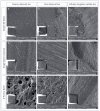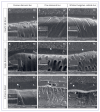Effect of Clinically Relevant Smear Layers and pH of Universal Adhesives on Dentin Bond Strength and Durability
- PMID: 35322946
- PMCID: PMC11734300
- DOI: 10.3290/j.jad.b2838121
Effect of Clinically Relevant Smear Layers and pH of Universal Adhesives on Dentin Bond Strength and Durability
Abstract
Purpose: To evaluate the effects of different smear layers on the microtensile bond strength (µTBS) of a reference two-step self-etch adhesive and two universal adhesives.
Materials and methods: Mid-coronal dentin of 90 teeth was exposed and divided into three bur groups (coarse diamond, fine diamond, or tungsten carbide). Each bur-prepared group was further divided into three adhesive groups: Clearfil SE Bond (SE, Kuraray Noritake), Single Bond Universal (SB; 3M Oral Care), and G-Premio Bond (GP, GC). After adhesive application, 4-mm-thick resin composites were built up. Half of the teeth in each bur-adhesive group were used in immediate µTBS testing, and the others were tested after thermal aging (n = 5). Rectangular sticks were prepared using a low-speed diamond saw. For each tooth, 6 central sticks were used in the µTBS test. Statistical analysis was performed using three-way ANOVA and Bonferroni tests (α = 0.05).
Results: SE presented higher µTBS than universal adhesives and SB presented higher µTBS than GP regardless of dentin surface preparation and thermal aging (p ˂ 0.05). For SE and SB, the tungsten carbide bur demonstrated higher immediate and aged µTBS than did the extra-fine diamond bur (p ˂ 0.05). The immediate µTBS was similar for GP with all bur types (p ˃ 0.05); the tungsten carbide and extra-fine diamond burs presented higher µTBS than did the coarse-diamond bur after thermal aging (p ˂ 0.05).
Conclusion: Dentin surface preparation and adhesive type had significant effects on µTBS. The smear layer created with an extra-fine diamond or tungsten carbide bur is favorable when mild and ultra-mild self-etch adhesives are used.
Keywords: bond strength; microtensile bond strength; self-etch adhesives; smear layer; universal adhesive.
Figures



Similar articles
-
Effect of Smear Layers Created by Different Burs on Durability of Self-Etching Adhesive Bond to Dentin of Primary Teeth.J Clin Pediatr Dent. 2015 Spring;39(3):224-30. doi: 10.17796/1053-4628-39.3.224. J Clin Pediatr Dent. 2015. PMID: 26208066
-
Potential smear layer interference with bonding of self-etching adhesives to dentin.J Adhes Dent. 2013 Aug;15(4):317-24. doi: 10.3290/j.jad.a29554. J Adhes Dent. 2013. PMID: 23593634
-
Bonding Performance of Self-etching Adhesives to Bur-cut Dentin with Active Application Mode.J Adhes Dent. 2021 Jul 23;23(4):357-365. doi: 10.3290/j.jad.b1645379. J Adhes Dent. 2021. PMID: 34269546
-
Influence of tooth preparation burs on the roughness and bond strength of adhesives to human dentin surfaces.Am J Dent. 2011 Jun;24(3):176-82. Am J Dent. 2011. PMID: 21874939
-
Variable Smear Layer and Adhesive Application: The Pursuit of Clinical Relevance in Bond Strength Testing.Int J Mol Sci. 2019 Oct 29;20(21):5381. doi: 10.3390/ijms20215381. Int J Mol Sci. 2019. PMID: 31671751 Free PMC article.
Cited by
-
Effect of double-layer application techniques on the dentin micro-tensile bond strength of universal adhesives.BMC Oral Health. 2025 Jul 22;25(1):1231. doi: 10.1186/s12903-025-06617-8. BMC Oral Health. 2025. PMID: 40696338 Free PMC article.
-
Does reducing the acid-etching time increase the micro-tensile bond strength of a bulk fill composite to dentin using different universal adhesives?BMC Oral Health. 2025 Mar 20;25(1):412. doi: 10.1186/s12903-025-05602-5. BMC Oral Health. 2025. PMID: 40114102 Free PMC article.
References
-
- Ahmed MH, Yoshihara K, Mercelis B, Van Landuyt K, Peumans M, Van Meerbeek B. Quick bonding using a universal adhesive. Clin Oral Investig. 2019;24:2837–2851. 1–15. - PubMed
-
- Armstrong S, Breschi L, Özcan M, Pfefferkorn F, Ferrari M, Van Meerbeek B. Academy of Dental Materials guidance on in vitro testing of dental composite bonding effectiveness to dentin/enamel using micro-tensile bond strength (μTBS) approach. Dent Mater. 2017;33:133–143. - PubMed
-
- Chowdhury A, Saikaew P, Alam A, Sun J, Carvalho RM, Sano H. Effects of double application of contemporary self-etch adhesives on their bonding performance to dentin with clinically relevant smear layers. J Adhes Dent. 2019;21:59–66. - PubMed
-
- Cuevas-Suarez CE, de Oliveira da Rosa WL, Lund RG, da Silva AF, Piva E. Bonding performance of universal adhesives: an updated systematic review and meta-analysis. J Adhes Dent. 2019;21:7–26. - PubMed
MeSH terms
Substances
LinkOut - more resources
Full Text Sources
Miscellaneous

